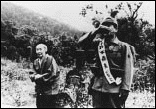--Furuyashikimura |
|
 |
製作:小川プロダクション Production Company : Ogawa Productions |
| 牧野より蔵王山中に入った戸数わずか八戸の古屋敷村。小川とそのスタッフは1980年の冷害をきっかけにシロミナミと呼ばれる古屋敷村独特の冷気を立体地形図の実験で再現し、冷害の原因究明をはじめた。こうした科学的な分析は、顕微鏡撮影による稲の開花や地質調査にまで及び、徐々に古屋敷村の冷害の歴史に移行しはじめる。そして老人達の個人史が語られ、かつて盛んだった炭焼き、村と町をつなぐ一本道の近代化がもたらせた過疎、最後の炭焼きとその母が語る戦死した息子たちの記憶と路傍の碑に込められた家の歴史、かつて植民地「満洲国」へと渡り帰還した老人や、ニューギニアで戦争体験し今でも軍隊ラッパを高らかに吹く老人たちの語りとともに、歴史が昨日の記憶であるかのように甦りはじめる。こうして昭和史へと至る古屋敷村の歴史はいつの間にか「ニッポン国」の歴史にまで広がりをみせるのである。山形に移り住んだ小川が80年代になって発表した最初の成果であり、全フィルモグラフィー中突出した傑作とも言われた。ベルリン国際映画祭国際映画批評家賞も受賞し、小川を改めて世界的なドキュメンタリー映画作家の一人として認識させた。 | Furuyashikimura: a hamlet of just eight houses in the Zao mountains close to Magino. When the cold weather of 1980 damaged their rice crop, Ogawa and his staff went to Furuyashiki to investigate the peculiar chill. In order to begin to investigate the causes of the damaging cold weather, they performed experiments that reproduced the flow of cold air on a three dimensional topographical model. Their scientific analysis extended as far as geological surveys and the use of microscopic photography to record the blooming of a rice flower, but gradually the focus of the film shifts to the history of crop damage due to cold weather in Furuyashiki. The old people also tell the filmmakers their personal histories, about the charcoal making that used to flourish, and the depopulation that the modernization of the single road connecting the hamlet to the town caused. The last charcoal maker and his mother remember the sons who died in the war and the family history that is wrapped up in the roadside gravestones. An old man speaks of journeying to the colony of Manchuria and of being repatriated, while other old soldiers who were stationed in New Guinea play the military bugle proudly. As they do so, history is brought back to life as if it were yesterday, and at some point the history of Furuyashiki during the Showa period broadens into a history of the modern Japanese State. This is the first film Ogawa completed in the 1980s after moving to Yamagata and is recognized as a masterpiece that stands out from the rest of his films. It won the FIPRESCI (film critics) prize at the Berlin International Film Festival and brought Ogawa recognition once again as a world class documentary filmmaker. |